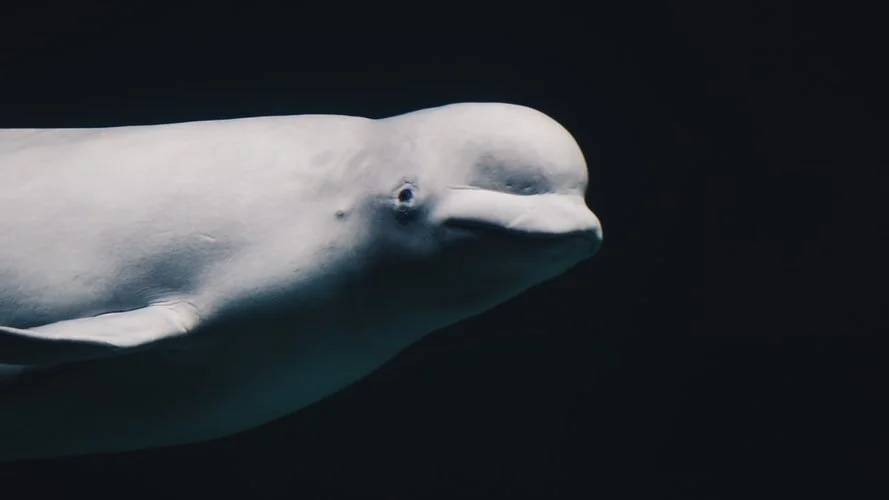The North Pole is home to some truly captivating wildlife that enjoy life on and around the sea ice. Snuggle up with your little pup, and read about eight wonderful Arctic animals that are living in the extreme winter conditions at the top of the globe.
#1: Beluga Whales
These cetaceans are one of the cutest animals under the sea. Just look at their signature smile! Belugas, also known as white whales, are relatively small whales that live in pods (groups) in the Arctic. They are one of the few species that can swim forward, backward, and upside down, and can fully turn their neck in every direction. They also have fantastic vision, and some scientists even suspect that they see in color. Known as "sea canaries”, belugas are one of the most vocal of all whales.
Photo credit: Mendar Bouchali
#2: Seals
Six seal species live in the Arctic: bearded, harp, hooded, ribbon, ringed (below) and spotted. Arctic seals are swift and graceful swimmers who do all of their hunting in the ocean, so a variety of marine creatures are on the menu. They tend to have quite a generalized diet, hunting for a range of different fish, crustaceans, squid, mollusks and marine invertebrates, depending on what foods are abundant in their area.
Although sea ice affects all these seal species, bearded, harp and ringed seals have life cycles that are tightly linked to sea ice. They need the ice's solid surface to carry out basic survival activities, from resting to molting to raising young. In fact, ringed seals give birth and nurse pups directly on the sea ice surface. (Yet another reason to preserve Arctic sea ice!)
Photo credit: Carsten Egevang
#3: Walruses
You’re probably familiar with their distinctive tusks, but these incisors don’t just look cool. Walrus tusks are incredibly strong and tusk size determines a social standing. They can even use their tusks like grappling hooks to pull themselves out of the water. Their Latin name, Odobenus rosmarus, translates to “tooth walking seahorse”. Walruses spend a lot of time on land or pack ice. They appear to move slowly and sluggishly, however, unlike seals, walruses can move on all fours allowing them to run as fast as humans in short spurts. In the water, they are quite graceful and can stay under for up to 30 minutes.
Photo credit: Pixabay photographer, skeeze
#4: Orcas
Sure orcas are deadly, but that doesn’t make them any less beautiful. Even though they’re often called killer whales, orcas are actually dolphins. These hunters are extraordinarily social and smart, and their pods have distinctive vocal calls so they can always find their way back to the right home. Each pod has its own culture, language, and hunting tactics. Some pods partner with Inuit hunters by guiding whales into bays. In return, the hunters give the orcas some of the whale meat. Orcas can swim up to 40 miles a day, foraging for food and exercising.
Photo credit: Pixabay photographer, skeeze
#5: Narwhals
Commonly called the unicorns of the sea, these majestic mammals are absolutely real. Unlike some whale species that migrate, narwhals spend their lives in the Arctic waters of Canada, Greenland, Norway and Russia. The tusk—most commonly found on males—is actually an enlarged tooth with sensory capability and up to 10 million nerve endings inside. This hypersensitive tooth is used for heightened awareness of nearby dangers or food. Narwhals, like most toothed whales, communicate with "clicks", "whistles", and "knocks". They can live up to 50 years.
Photo credit: Glenn Williams
#6: Hares
There are three kinds of hares living in the region: the Arctic hare, the snowshoe hare, and the mountain hare. All three have white coats with darker markings on the tips of their ears. In summer, they swap their snowy fur for warm brown coats in order to keep up their camouflage as the snow melts. This switch is typical for hares and distinguishes them from their rabbit relatives. Food can be scarce in the Arctic, but the hares survive by eating woody plants and mosses, which they may dig through the snow to find in winter. In other seasons they eat berries, leaves, roots, and bark.
Photo credit: Pixabay photographer, tpsdave
#7: Arctic Fox
Arctic foxes are quite curious and often investigate hikers, scientists, and any equipment left out. Arctic foxes are wanderers, and generally live alone, except during mating season. They live for about 10 to 15 years. To survive the winter, they build cozy and complex underground burrows - some with over 100 entrances. In summer, they have a light brown coat, but - like hares - they grow thick white fur during the colder months. They also use their fluffy tails as blankets to curl up with during the freezing nights.
Photo credit: Pixabay photographer, StockSnap
#8: Lemmings
Lemmings are small, mice-like rodents. Lemmings don’t hibernate through the harsh northern winter. They remain active, finding food by burrowing through the snow and using grasses clipped and stored in advance. Lemming colonies need to migrate frequently to find new food sources in the icy tundra, and - believe it or not - these little cuties know how to swim.
Photo credit: Polar Discovery
Our team is doing everything we can to safely preserve and restore the Arctic habitat. While we have connected with a number of marine biologists, we could still use a biology expert to serve on our advisory panel. If interested, please email us at info@ice911.org. Thank you.
- Genevieve Imboden








